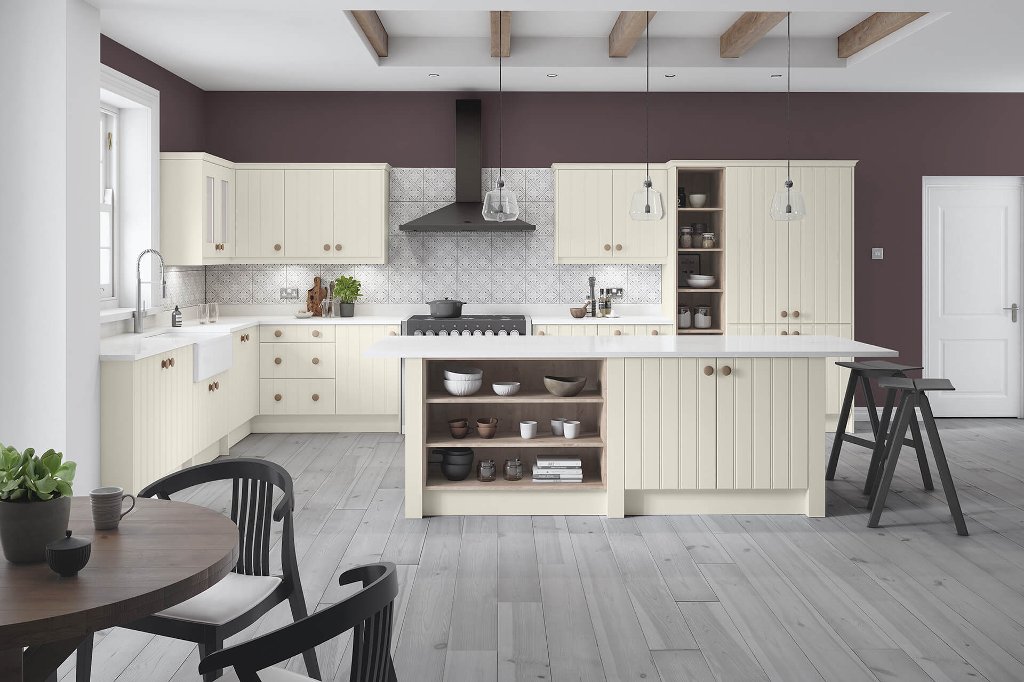Kitchen Cornice in Detail

What is a Cornice in a Kitchen?
In the realm of kitchen design, the cornice is often the unsung hero that brings everything together. A cornice is a decorative moulding that sits atop your wall kitchen units and tall units, providing a polished and refined finish. It's the top trim that adheres to the overall design aesthetic of your kitchen, much like the cherry on top of a cake.
Where Does the Cornice Go in a Kitchen?
The cornice is strategically placed on top of wall units and tall units. It serves as the kitchen cupboard cornice, seamlessly integrating with the rest of your kitchen design.
Do You Need Cornice on Kitchen Units?
While you might consider a cornice optional, it's actually a crucial element that completes the look of your kitchen. Without it, your kitchen may feel incomplete, as if something is missing.
The tops of the units, otherwise bare, are given a finished look, making the cornice an indispensable part of your kitchen's wall unit trim.
How to Fix Cornice to Kitchen Units
Installation is a precise task. After all wall and tall units are in place, your kitchen installer will measure the required length and determine where the joins need to be cut. It's vital that the cut is perfect to ensure all edges are hidden, maintaining a seamless look.
What is the Difference Between Cornice and Pelmet?

While both are finishing touches, a cornice is placed at the top of your units, whereas a pelmet is fitted at the bottom. Both serve to enhance the overall design but are positioned differently.
Cornice Options to Consider
When it comes to cornice options, you have 4 main options to choose from:
Square Bullnose: Best for modern kitchens
The Square Bullnose cornice features clean, straight lines and a flat surface, making it the go-to choice for modern or industrial-style kitchens. Its simplicity allows it to blend seamlessly with sleek cabinetry and contemporary finishes, enhancing the overall minimalist aesthetic.Classic: Timeless and versatile
The Classic cornice is characterised by its subtle curves and understated elegance. This style is incredibly versatile, making it suitable for a wide range of kitchen designs, from traditional to transitional. Its timeless appeal ensures that your kitchen will never go out of style.Traditional: Ideal for farmhouse or rustic kitchens
The Traditional cornice boasts intricate detailing and ornate designs, making it the perfect fit for farmhouse, rustic, or even vintage-themed kitchens. This style often features decorative elements like fluting or dentil moulding, adding a touch of historical charm to your space.Contemporary: Suits Minimalist or Avant-Garde Designs
The Contemporary cornice is all about boldness and innovation. Often crafted from unconventional materials like metal or acrylic, this style complements kitchens that push the boundaries of design. Its avant-garde nature makes it ideal for those looking to make a strong design statement.
Choosing the wrong cornice can detract from your kitchen's beauty, so it's crucial to pick one that complements your style.
FAQ Title: Your Cornice Questions Answered
Explore our comprehensive FAQ section to get answers to your most pressing questions about kitchen cornices. From styles and materials to installation and customisation, we cover all you need to know to make an informed decision for your kitchen's finishing touch.
What is a kitchen cornice?
A kitchen cornice is a decorative moulding that sits on top of your kitchen units to provide a finished look.
Where should the cornice be placed in a kitchen?
The cornice should be placed on top of wall and tall kitchen units.
Is a cornice necessary for kitchen units?
While a cornice is optional, it serves as a crucial finishing touch that completes the look of your kitchen.
How is a cornice installed on kitchen units?
A cornice is measured and cut to fit by a professional installer, who then attaches it to the top of your kitchen units.
What is the difference between a cornice and a pelmet?
A cornice is placed at the top of your kitchen units, whereas a pelmet is fitted at the bottom.
What styles of kitchen cornice are available?
Available styles of cornice include Square Bullnose, Classic, Traditional, and Contemporary.
Can I install a kitchen cornice myself?
Yes, it is possible to install the cornice yourself. However, for a seamless finish, it's recommended to have the cornice installed by professionals if you do not have the appropriate tools or DIY skills.
What materials are commonly used for kitchen cornices?
Kitchen cornices are typically made of wood, MDF, or plaster.
How do I choose the right cornice style for my kitchen?
To choose the right cornice style, consider the overall design theme of your kitchen and select one that complements it.
Can a kitchen cornice be customised?
Yes, kitchen cornices are generally supplied in lengths and can be customised onsite to fit your specific kitchen dimensions.
Conclusion: Elevate Your Kitchen Today
The cornice is more than just a decorative piece; it's the finishing touch that elevates your kitchen from good to great. Don't overlook this essential element. Browse our range of cornices and find the perfect one to complete your dream kitchen.
Ready to transform your kitchen? Visit our showroom or shop online to find the cornice that speaks to your style.

